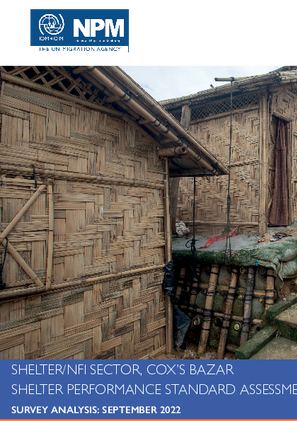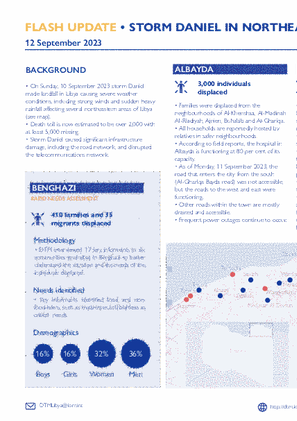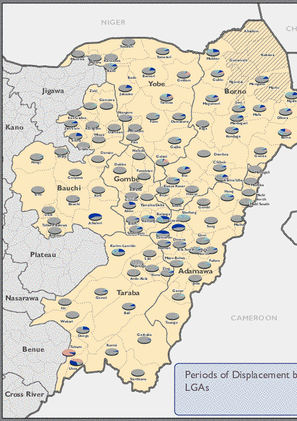-
Countries
-
Data and Analysis
-
Special Focus
-
Crisis Responses

Contact
NPM Bangladesh, npmbangladesh@iom.int
Language
English
Location
Bangladesh
Period Covered
Mar 01 2021
Nov 30 2021
Activity
- Survey
- Community Perception
In response to shelter reconstruction after the March 22nd fire in 2021, MoDMR shared an “Approval of design for construction of shelters in Rohingya camps” on April 4th (including single storey shelters and specification of the materials to be used) stating that a “single storey shelter of 10 feet x 15 feet size can be constructed for one household if construction of double storey shelter is not possible because of positional reason”. The RRRC issued a document entitled “Approval of basic principles for construction of shelter in FDMN camps” (15 April 2021) stating that “at the moment only one storied shelter will be constructed in the FDMN camps considering quick re-construction of shelters due to the massive fire incident and imminent monsoon”. The RRRC then requested the Shelter/NFI Sector and IOM to provide a design.
● The design of a shelter of 10 feet x 15 feet (150 sq. feet) was approved on April 25th, only for the reconstruction of shelters affected by the fire on March 21st
● In the submitted document, it was proposed that this shelter size (150 sq. feet) is for up to four family members (standard family size) and 1.5 shelters (225 sq. feet) can be provided for up to six family members and two shelter units1 (300 sq. feet) for seven or more family members to ensure dignified living conditions.
However, the RRRC subsequently communicated that the approved design of 150 sq. ft. is for the HHs with up to six family members and that the same design should be followed across all the camps, not only for shelters affected by the March fire. This design is currently the only approved one for single-storey mid-term shelters (MTS), and the RRRC no longer recognizes its previous MTS design approvals. To reinforce the advocacy with the government on dignified living conditions, there is a need for a comprehensive and independent survey across the camps to measure the perception of the new design and impact of the reduced size. This survey targeted 3 camps where MTS were built based on the approved design. All the responses are based on the HHs perception, no technical verification was included in this assessment.

Contact
NPM Bangladesh, npmbangladesh@iom.int
Language
English
Location
Bangladesh
Period Covered
Sep 01 2020
Oct 31 2021
Activity
- Survey
- Community Perception
At any given time, multiple assessments are underway to inform the humanitarian response in Cox’s Bazar, Bangladesh, where more than 929,000 Rohingya have sought refuge since 2017. However, data is lacking on the unique needs, preferences, and perceptions of persons with disabilities. A series of workshops with the Age and Disability Working Group (ADWG) identified the need to know how people with disabilities – both in camps and in host communities – feel about the response and their barriers to healthcare access. We hope to identify ‘blind spots’ in programming, help national and international actors deliver more equitable services, inform more inclusive performance indicators, and build trust. In November 2021, Ground Truth Solutions (GTS) and the International Organisation for Migration’s (IOM) Needs and Population Monitoring unit (NPM) conducted qualitative interviews with persons with mobility and vision impairments from Rohingya refugee and host community populations with the aim of better informing and supporting agencies in developing disability-inclusive programmes and engagement activities. In line with our findings that “who asks the questions” can bias responses, 1 NPM mobilised a Bangladeshi–Rohingya enumerator team. Three days of specialised training included input from ADWG technical experts on disability-inclusive communication. This report’s ‘user journeys’ involve seven composite personas - fictional characters derived from 33 semi-structured interviews - which help establish a narrative of people’s lived experiences. Given available resources, the nature of this approach, and the prevalence of different types of disabilities, we focused on people with mobility and vision impairments.
Key findings
• People with disabilities face significant barriers in using feedback mechanisms. They worry that providing feedback will affect them negatively, or won’t be considered.
• There is widespread confusion over aid eligibility requirements, support groups, and care options.
• Although Covid-19 messaging is widespread, dangerous rumours persist about what happens to those who seek treatment.
• Spirituality and traditional beliefs influence people’s decision-making around healthcare. This highlights the importance of religious leaders in communication.
• Costs are prohibitive and facilities lack the reasonable accommodation and supplies necessary for people with disabilities or long-term illnesses.
• Precarious terrain is a barrier to healthcare access.

Contact
NPM Bangladesh, npmbangladesh@iom.int
Language
English
Location
Bangladesh
Period Covered
Mar 01 2021
Aug 09 2022
Activity
- Survey
- Community Perception
The total number of Rohingya refugees in Cox’s Bazar is around 936,733 individuals1 . The Rohingya refugee population is concentrated in 33 extremely congested camps within Ukhiya and Teknaf Upazilas of Cox’s Bazar district, Bangladesh. The refugees living in the camps are dependent on the assistance provided by the humanitarian community and the government of Bangladesh. Shelters are exposed to cyclic monsoons and face risk of floods, landslides, fire and cyclones. Temporary materials such as bamboo and tarpaulin have a limited capacity to resist weather impacts, and thus require regular repairs and replacement. Use of adequate material (treated bamboo, good quality tarpaulin) along with the design, site plan, proper technical details for the materials connections, can improve lifespan of materials if properly followed. Training for the beneficiaries on how to repair and maintain their shelters is also one of the essential elements of shelter assistance to ensure less dependency on humanitarian support. The below document represents findings from the joint assessment of the SNFI Sector and NPM on the Shelter Performance Standards which reflect shelters conditions across 33 camps.

Contact
DTMUkraine@iom.int
Language
English
Location
Ukraine
Period Covered
Aug 15 2023
Aug 22 2023
Activity
- Other
- Community Perception
- Mobility Tracking
To support ongoing humanitarian winterization operations, the Solid Fuel Assessment report serves to identify the heating systems used in Ukrainian households and estimate the prices of solid fuel items across Ukraine. Additionally, it examines the demand for, supply of, and pricing dynamics of essential solid fuel items both at the time of the assessment and in the upcoming month.
Data collection took place from August 15 to 22 August in all 23 oblasts. In each oblast, data was collected in at least two locations, one urban and one rural and near frontline locations, where applicable (i.e., Chernihivska, Donetska, Dnipropetrovska, Kharkivska, Khersonska, Mykolaivska, and Sumska Oblasts). In each location, a minimum of two local vendors and two community focal points (CFPs) were surveyed through face-to-face or remote interviews.

Contact
DTMLibya@iom.int
Language
English
Location
Libya
Snapshot Date
Sep 12 2023
Activity
- Other
On Sunday, 10 September 2023 storm Daniel made landfall in Libya causing severe weather conditions, including strong winds and sudden heavy rainfall affecting several northeastern areas of Libya (see map). Death toll is now estimated to be over 2,000 with at least 5,000 missing. Storm Daniel caused significant infrastructure damage, including the road network, and disrupted the telecommunications network.
IDPs per period of displacement at the LGA level
Returnees comparison at the location in A0. Change in the number of returnees compared to Round 44.
IDP comparison at the location in A0. Change in the number of IDPs compared to Round 44.
IDPs and Returnees Locations in A0.
Location of previous displacements of the majority of returnees.




